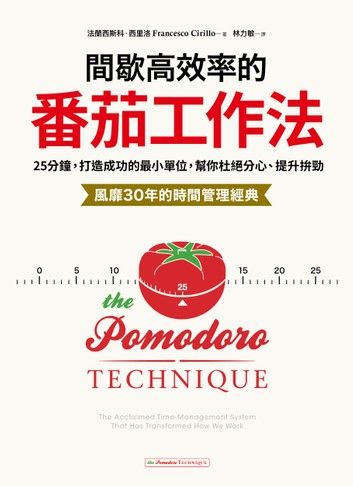Can procrastination be cured? Try the simple and efficient Pomodoro Technique!
After working from home, although I can use my time freely, it is inevitable that I will be disturbed by housework. In addition, work and rest time are mixed together, resulting in a busy day, extremely low work efficiency, and affected rest quality. Until recently, when I came into contact with the Pomodoro Technique, I finally found a way to allocate my time. More importantly, I set goals every day, made steady progress, and felt a lot more stable.

"Pomodoro Technique": The executor uses a timer to time, after 25 minutes of continuous work, a 5-minute break, and the cycle continues until the end of the working time.
But when I read the book "The Pomodoro Technique with Intermittent Efficiency", I realized that the Pomodoro Technique is not just "pressing the clock, timing, and doing things", it actually includes methods for setting goals, improving goals, and using By uniting working hours and measuring the time required for each job, the goals of each working period are obvious and easier to achieve. In addition, work when it is time to work, and rest when it is time to rest, so as to improve concentration at work, which is also a major feature of this work method.

The following are the key reading notes I have compiled. Some of the content has been internalized and fine-tuned. Even if you don't have time to read this book, you might as well try the "Pomodoro Technique" to improve the quality of your work.
The Pomodoro Technique consists of three steps:
- Plan: At the beginning of the day, decide what to do for the day.
- Tracking: Keep track of your execution as you work.
- Record and Reflect: At the end of the day, record the results of each day, organize information and improve.
plan:
- At the beginning of the day's work, write the performer's name and date on the today's worksheet.
- List the work items for today, and note the number of Pomodoros required for each task next to it. Each Pomodoro represents 25 minutes of work time and 5 minutes of rest time.
Such as: writing a new book review 2. This means that you estimate that you will need 2 Pomodoros (50 total work hours) to finish writing a new book review. - Pomodoros are inseparable. There are no half or 1/4 Pomodoros, only 1, 2...full Pomodoros. This is to let the executor be familiar with the time length of a Pomodoro correctly, and then the planning and execution will become more and more accurate.
- If an item takes more than 5-7 Pomodoros, break it down into smaller items. If something takes less than 1 Pomodoro, group similar items together to form a Pomodoro.

Tracing (performing the Pomodoro Technique):
- Start the timer, expand your Pomodoro, the Pomodoro cannot be interrupted , and you must concentrate on executing the previously listed tasks for 25 minutes.
- After the Pomodoro rings, be sure to stop working and draw an X next to the item. An X represents the completion of a Pomodoro, so as to record the number of Pomodoros that are really needed to execute the item.
- Take a 5 minute break. Take short, relaxing breaks to get away from important work completely.
- After every 4 Pomodoros, take a long break of 15 to 30 minutes. Let the mind regroup and integrate.
- When you finish an item, cross it out.
Reduce distractions:
When you encounter interruptions while running a Pomodoro, you should look at it objectively and adjust the plan as needed:
- When you encounter an internal distraction (self-distraction), make a note "'" on the worksheet. When you encounter external disturbance (other people disturb), draw a horizontal "-" mark on the worksheet.
- Record the interruption under "Temporary Urgent Matters" below today's worksheet. Less important matters can have deadlines noted.
- After writing it down, go back to your previous work immediately until the Pomodoro rings.
- Take breaks to work on smaller "immediate rushes," schedule rushes to replace other Pomodoro slots, or delete unnecessary items.

Correction and Reflection:
At the end of the day, re-examine the daily worksheet to see the difference between the estimated number of Pomodoros for each item and the actual execution, as a reference for the next estimate. Over time, executors can more and more understand the time meaning and workload represented by a Pomodoro, and set up new progress indicators. thereby improving work efficiency.
In addition, the work items that are crossed out on the daily work table also represent the results of your day's work. Just like the daily task list in the game, by completing each Pomodoro, enhance the sense of accomplishment at work.

Benefits of Pomodoro:
- Clearly set the time and goals of the work items: let the executors have an understanding of the whole day's projects as soon as they go to work, follow the schedule and focus on each Pomodoro project.
- Separating work time and rest time: When the brain is properly rested, it can function at full capacity while working.
- For executors to measure work results: The Pomodoro Technique is not only a method of time management, but also includes the advantages of setting goals, understanding the problems encountered during execution, modifying goals, and so on.
- Flexible modification according to personal conditions: Pomodoro can be adjusted to a cycle of 20 to 45 minutes depending on personal conditions. If you continuously perform brain-intensive Pomodoros, you can take a long break in advance.
How to choose the right Pomodoro timer?
Basically, as long as the timer can count the time correctly and beep when the time is up, it is a proper Pomodoro.
Personally, I am used to using the mobile phone APP "Focus on Forest" to time the clock. The screen is clean and cute. Every time I complete a Pomodoro, I can plant a tree. During the timing, I cannot use other functions of the mobile phone, otherwise the tree will die, so it can also prevent distraction.

Or use the more powerful "Flat Tomato" to manage work items, projects and required time directly on the APP, which is also a good choice.

Epilogue
In the past, when I went to work every day, I started to work hard without thinking about it. After a day of work, I was exhausted and exhausted. Wherever I thought about reflection and progress, it was too late to rest. But now, because of the Pomodoro Technique, I have a clear one-day goal and a method to improve efficiency. Although I am still adjusting my writing rhythm, I don’t have much experience in improving my work results, but at least I have listed it myself. The tasks are completed one by one, and the sense of accomplishment obtained is much greater than before.
In the final analysis, no matter what kind of work method, the most important thing is to concentrate on work, follow the schedule, and persevere, and the Pomodoro Technique very considerately plans the rest time, so that the executor not only plans the work, but also small rewards in the workplace. (rest) is also planned together. Although the work is still very hard, I think that after this Pomodoro is over, I can watch a small video and eat snacks with peace of mind, which may be one of the reasons why I can stick to the Pomodoro Technique.
The Pomodoro Technique is simple and intuitive, and you are welcome to join the ranks of Pomodoro workers!

If you like my article, please help me clap + follow, new writers need support, thank you!
Like my work? Don't forget to support and clap, let me know that you are with me on the road of creation. Keep this enthusiasm together!

- Author
- More